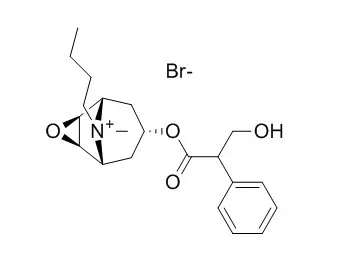| Animal Research: |
| Carcinogenesis. 2011 Sep;32(9):1396-402. | | Muscarinic receptor subtype-3 gene ablation and scopolamine butylbromide treatment attenuate small intestinal neoplasia in Apcmin/+ mice.[Pubmed: 21705482] | M3 subtype muscarinic receptors (CHRM3) are over-expressed in colon cancer.
METHODS AND RESULTS:
In this study, we used Apc(min/+) mice to identify the role of Chrm3 expression in a genetic model of intestinal neoplasia, explored the role of Chrm3 in intestinal mucosal development and determined the translational potential of inhibiting muscarinic receptor activation. We generated Chrm3-deficient Apc(min/+) mice and compared intestinal morphology and tumor number in 12-week-old Apc(min/+)Chrm3(-/-) and Apc(min/+)Chrm3(+/+) control mice. Compared with Apc(min/+)Chrm3(+/+) mice, Apc(min/+)Chrm3(-/-) mice showed a 70 and 81% reduction in tumor number and volume, respectively (P < 0.01). In adenomas, β-catenin nuclear staining was reduced in Apc(min/+)Chrm3(-/-) compared with Apc(min/+)Chrm3(+/+) mice (P < 0.02). Whereas Apc gene mutation increased the number of crypt and Paneth cells and decreased villus goblet cells, these changes were absent in Apc(min/+)Chrm3(-/-) mice. To determine whether pharmacological inhibition of muscarinic receptor activation attenuates intestinal neoplasia, we treated 6-week-old Apc(min/+) mice with Scopolamine butylbromide, a non-subtype-selective muscarinic receptor antagonist. After 8 weeks of continuous treatment, Scopolamine butylbromide-treated mice showed a 22% reduction in tumor number (P = 0.027) and a 36% reduction in tumor volume (P = 0.004) as compared with control mice. Compared with Chrm3 gene ablation, the muscarinic antagonist was less efficacious, most probably due to shorter duration of treatment and incomplete blockade of muscarinic receptors.
CONCLUSIONS:
Overall, these findings indicate that interplay of Chrm3 and β-catenin signaling is important for intestinal mucosal differentiation and neoplasia and provide a proof-of-concept that pharmacological inhibition of muscarinic receptor activation can attenuate intestinal neoplasia in vivo. | | J Gastroenterol. 2003;38(7):629-35. | | Comparison of gastric peristalsis inhibition by scopolamine butylbromide and glucagon: evaluation by electrogastrography and analysis of heart rate variability.[Pubmed: 12898354] | Activation of glucagon receptors of the smooth muscle membrane suppresses gastric peristalsis. We evaluated autonomic nervous activity by two methods, electrogastrography (EGG) and analysis of heart rate variability, to compare the inhibiting effects of glucagon and Scopolamine butylbromide on gastric peristalsis.
METHODS AND RESULTS:
Heart rate variability, EGG, and blood catecholamine levels were measured before and after administration of glucagon (G group), Scopolamine butylbromide (SB group), or physiological saline (C group). Autonomic nervous function was evaluated using spectral analysis of heart rate variability, and low frequency (LF) and high frequency (HF) power; the LF/HF ratios were also determined.
After administration of Scopolamine butylbromide, HF power, an index of parasympathetic nervous activity, decreased; and the LF/HF ratio, an index of sympathetic nervous activity, increased. In contrast, no significant change was observed in autonomic nervous activity after administration of glucagon. The peak power amplitudes of the EGG decreased significantly in the G and SB groups after intramuscular injection, but the difference between the groups was not significant. Furthermore, the dominant frequency increased significantly in the G and SB groups after injection. Serum catecholamine levels showed no significant changes after administration of Scopolamine butylbromide or glucagon.
CONCLUSIONS:
Inhibition of gastric peristalsis by glucagon via glucagon receptors on smooth muscles did not influence autonomic nervous activity, unlike the results obtained after administration of Scopolamine butylbromide. Therefore, glucagon may be safe for use with elderly patients and those with cardiopulmonary complications. |
|






 Cell. 2018 Jan 11;172(1-2):249-261.e12. doi: 10.1016/j.cell.2017.12.019.IF=36.216(2019)
Cell. 2018 Jan 11;172(1-2):249-261.e12. doi: 10.1016/j.cell.2017.12.019.IF=36.216(2019) Cell Metab. 2020 Mar 3;31(3):534-548.e5. doi: 10.1016/j.cmet.2020.01.002.IF=22.415(2019)
Cell Metab. 2020 Mar 3;31(3):534-548.e5. doi: 10.1016/j.cmet.2020.01.002.IF=22.415(2019) Mol Cell. 2017 Nov 16;68(4):673-685.e6. doi: 10.1016/j.molcel.2017.10.022.IF=14.548(2019)
Mol Cell. 2017 Nov 16;68(4):673-685.e6. doi: 10.1016/j.molcel.2017.10.022.IF=14.548(2019)